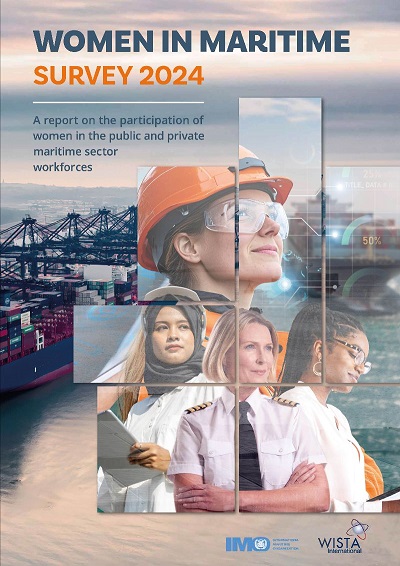
The second IMO–WISTA report on gender diversity in shipping reveals that women continue to face significant discrimination in the maritime workplace despite progress in certain areas.
As part of a broader cooperation between the International Maritime Organization (IMO) and Women’s International Shipping & Trading Association (WISTA), the IMO–WISTA Women in Maritime Survey 2024 presents data on the proportion of women working in the sector from member states and the private sector. It offers new insights following an inaugural survey, conducted in 2021.
In this second round of research, 88 IMO member states and 608 private organisations participated – up from 45 member states and 503 private organisations in 2021. As a result, the 2024 report based its analysis on a larger number of women working in shipping’s public and private sectors: 176,820 compared to 151,979 in 2021.
“Improved participation not only provides a more accurate overview regarding the share of the maritime workforce accounted for by women; it also indicates enhanced awareness of – and greater commitment to addressing – persistent issues surrounding gender diversity and inclusion,” said Elpi Petraki, President, WISTA International. “However, recognition is only the first step towards solving these issues, and closer inspection of the findings in the Women in Maritime Survey 2024 reveals the true extent of the challenge ahead.”

The latest results are not directly comparable to the 2021 survey due to a variation in respondents, but they suggest that the female share of the workforce is smaller than was previously understood. In what should serve as a fresh wake-up call for the industry, women accounted for just 16% of the workforce in surveyed members states in 2024 – where 2021 findings indicated the share as 26%. In the private sector, the shortfall was even more significant: 16% in 2024 against 29% in 2021.
Gender inequality in the seafaring cohort is particularly evident: of the 211,750 mariners employed by respondents to the 2024 survey, just 2,223 – a little over one per cent – are female.
If statistics alone do not fully illustrate the persistent barriers women face in pursuing a career at sea, open-ended survey questions offered sometimes startling context with a representative of one company explicitly stating, “We do not hire women in offshore support vessels.”
Such discriminatory hiring practices require fundamental change in culture and policy, which in turn calls for more female leaders in shipping. Indeed, the 2024 survey reveals that organisations with female board members were more likely to have gender-equality initiatives in place. Reports compiled by UN Women highlight a correlation between a company’s share of female leaders and its investment in human capital and environmental stewardship – both of which are critical to shipping’s long-term sustainability and growth.
The 2024 IMO–WISTA report paints a mixed picture regarding female leadership. Among the board members of the surveyed organisations, 34% are women – 6% up on 2021. However, while results varied widely by sub-sector, the overall representation of women in C-suite roles was lower by a quarter, from 761 in 2021 to 571 in 2024.
Considerably higher female representation was also logged in some roles: advertising, marketing, and public relations (from 29% in 2021 to 63% in 2024); port operations and services (21% to 53%); and ship broking and chartering (18% to 47%).
Other sub-sectors, however, captured lower female representation than the previous survey – in particular, bunkering (down from 33% in 2021 to 9% in 2024), IT hardware/software and/or electronic equipment (20% to 0%), and marine engineering/ship repair/shipyards (35% to 14%).
“Our latest findings indicate that while some progress has been made, there remains significant room for improvement when it comes to women’s representation in maritime leadership roles,” said Petraki. “Research shows the importance of female leadership not only in establishing policies to improve gender diversity but also in protecting shipping’s long-term viability. We must therefore redouble our efforts to elevate women to positions of influence within maritime.”
According to the 2024 survey, attracting more women into shipping – and encouraging them to stay – will rely on enhanced recruitment and retention initiatives alongside mentorship and leadership development programmes.
“We need to ensure that everyone has the opportunities they deserve, and such programmes will help to break down some of the barriers that currently exist. However, attracting and retaining women in the industry is not about replacing men or hiring people only because they are women. It’s about ensuring women with the right skills, experience and qualifications actually consider a career in the maritime industry and are aware of the opportunities available,” explains Petraki.
With more female leaders, organisations are better placed to strengthen their policy implementation to help guarantee a safe and supportive working environment for women, the report states. To track the effectiveness of gender diversity policies and promote transparency, the survey recommends that companies collect and share gender-disaggregated data about their workforce, including their female representation.
“The second IMO–WISTA survey provides a stark reminder – if any were needed – that we still have a long way to go in our mission to improve gender equality in shipping,” continued Petraki. “On a more positive note, recognition of the challenge is growing, and we now have a clearer idea of where we need to focus our efforts. The sooner we correct stubborn gender imbalances, the sooner we can make real change towards a fairer and more sustainable maritime industry.”
source: WISTA International
The opinions expressed herein are the author's and not necessarily those of The Xinde Marine News.
Please Contact Us at:
media@xindemarine.com






